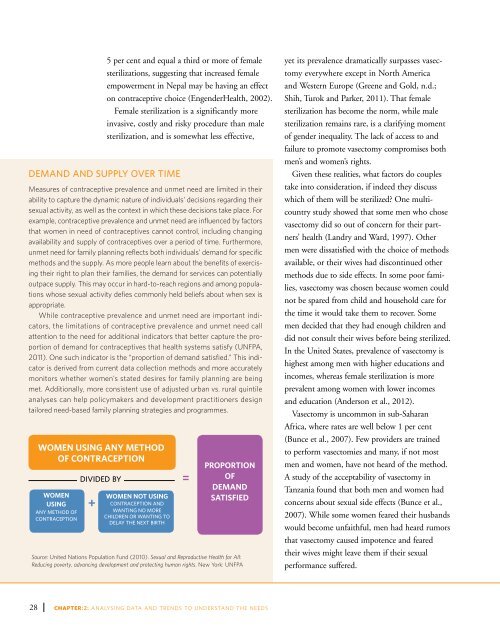State of World Population 2012 - UNFPA Haiti
State of World Population 2012 - UNFPA Haiti
State of World Population 2012 - UNFPA Haiti
Create successful ePaper yourself
Turn your PDF publications into a flip-book with our unique Google optimized e-Paper software.
Demand and supply over time5 per cent and equal a third or more <strong>of</strong> femalesterilizations, suggesting that increased femaleempowerment in Nepal may be having an effecton contraceptive choice (EngenderHealth, 2002).Female sterilization is a significantly moreinvasive, costly and risky procedure than malesterilization, and is somewhat less effective,Measures <strong>of</strong> contraceptive prevalence and unmet need are limited in theirability to capture the dynamic nature <strong>of</strong> individuals’ decisions regarding theirsexual activity, as well as the context in which these decisions take place. Forexample, contraceptive prevalence and unmet need are influenced by factorsthat women in need <strong>of</strong> contraceptives cannot control, including changingavailability and supply <strong>of</strong> contraceptives over a period <strong>of</strong> time. Furthermore,unmet need for family planning reflects both individuals’ demand for specificmethods and the supply. As more people learn about the benefits <strong>of</strong> exercisingtheir right to plan their families, the demand for services can potentiallyoutpace supply. This may occur in hard-to-reach regions and among populationswhose sexual activity defies commonly held beliefs about when sex isappropriate.While contraceptive prevalence and unmet need are important indicators,the limitations <strong>of</strong> contraceptive prevalence and unmet need callattention to the need for additional indicators that better capture the proportion<strong>of</strong> demand for contraceptives that health systems satisfy (<strong>UNFPA</strong>,2011). One such indicator is the “proportion <strong>of</strong> demand satisfied.” This indicatoris derived from current data collection methods and more accuratelymonitors whether women’s stated desires for family planning are beingmet. Additionally, more consistent use <strong>of</strong> adjusted urban vs. rural quintileanalyses can help policymakers and development practitioners designtailored need-based family planning strategies and programmes.WOMEN USING ANY METHODOF CONTRACEPTIONWOMENUSINGANY METHOD OFCONTRACEPTIONDIVIDED BY+WOMEN NOT USINGCONTRACEPTION ANDWANTING NO MORECHILDREN OR WANTING TODELAY THE NEXT BIRTHSource: United Nations <strong>Population</strong> Fund (2010). Sexual and Reproductive Health for All:Reducing poverty, advancing development and protecting human rights. New York: <strong>UNFPA</strong>=PROPORTIONOFDEMANDSATISFIEDyet its prevalence dramatically surpasses vasectomyeverywhere except in North Americaand Western Europe (Greene and Gold, n.d.;Shih, Turok and Parker, 2011). That femalesterilization has become the norm, while malesterilization remains rare, is a clarifying moment<strong>of</strong> gender inequality. The lack <strong>of</strong> access to andfailure to promote vasectomy compromises bothmen’s and women’s rights.Given these realities, what factors do couplestake into consideration, if indeed they discusswhich <strong>of</strong> them will be sterilized? One multicountrystudy showed that some men who chosevasectomy did so out <strong>of</strong> concern for their partners’health (Landry and Ward, 1997). Othermen were dissatisfied with the choice <strong>of</strong> methodsavailable, or their wives had discontinued othermethods due to side effects. In some poor families,vasectomy was chosen because women couldnot be spared from child and household care forthe time it would take them to recover. Somemen decided that they had enough children anddid not consult their wives before being sterilized.In the United <strong>State</strong>s, prevalence <strong>of</strong> vasectomy ishighest among men with higher educations andincomes, whereas female sterilization is moreprevalent among women with lower incomesand education (Anderson et al., <strong>2012</strong>).Vasectomy is uncommon in sub-SaharanAfrica, where rates are well below 1 per cent(Bunce et al., 2007). Few providers are trainedto perform vasectomies and many, if not mostmen and women, have not heard <strong>of</strong> the method.A study <strong>of</strong> the acceptability <strong>of</strong> vasectomy inTanzania found that both men and women hadconcerns about sexual side effects (Bunce et al.,2007). While some women feared their husbandswould become unfaithful, men had heard rumorsthat vasectomy caused impotence and fearedtheir wives might leave them if their sexualperformance suffered.28 CHAPTER:2: ANALYSING DATA AND TRENDS TO UNDERSTAND THE needs
















